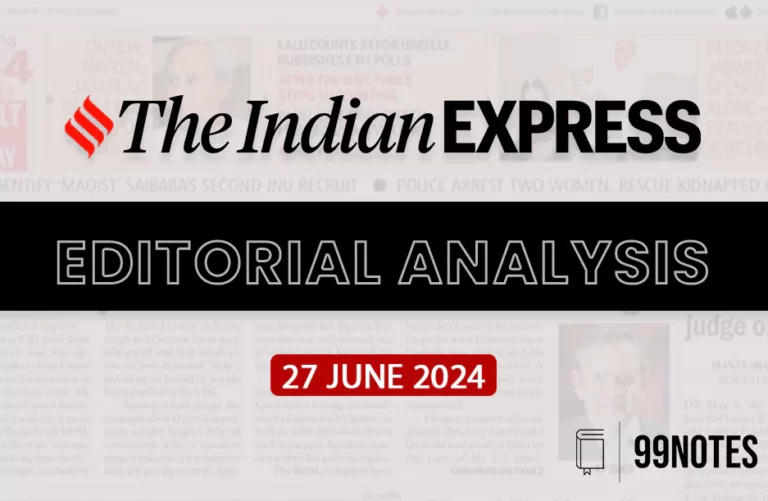1 July 2023 : Indian Express
Indian Express
1-July–2023
The Indian Express, CSE candidates can stay informed about current events and developments in India and around the world.
1. Justice, not uniformity
Syllabus – GS II
Context – The rising issue of the Uniform Civil Code.
Constitutional Status
- The provision for UCC is in Article 44 under Part IV of the Constitution, formulating a number of Directive Principles of State Policy, which are not enforceable by the courts but are to be “nevertheless fundamental in the governance of the country” (Article 37).
- Notably, it speaks of a uniform and not a common civil code — the difference being loud and clear— and directs the State to “endeavour to secure” it, not enact it at once.
- Reading it with the words of Article37— which prompt the State “to apply these principles in making laws” — indicates that the makers of the Constitution wanted uniformity to be gradually effected in the heterogeneous family law system of the country by suitably amending the old laws, and enacting new ones to serve the purpose.
Developments and Issues till Now
- Many new laws of general application have been enacted over the years — to name a few, the Special Marriage Act 1954, Dowry Prohibition Act 1961, Foreign Marriage Act 1969, maintenance law under the Criminal Procedure Code 1973, Protection of Women from Domestic Violence Act 2005, Prohibition of Child Marriage Act 2006, and Maintenance and Welfare of Parents and Senior Citizens Act 2007.
- The totality of these laws, each overriding contrary provisions of all personal laws, partly answers the demand of the Constitution for uniformity in family laws. By way of another step in this direction, various personal laws have been amended on almost similar lines.
- If enacted, a new comprehensive civil code will replace the personal laws of all communities, none of which are free from religious bias and gender inequalities.
- Under the Hindu Succession Act, the course of inheritance still depends on whether the deceased owner of a property was a man or a woman and of their descendants on the source of the property. Among the parents of the deceased, only the mother is a preferential heir; the father is excluded by many other preferential heirs whose list was illogically enlarged in 2005.
- Under the adoption law, a man needs his wife’s consent for adopting a child, and even for giving their child for adoption to someone else, only if she belongs to the same faith.
- The Special Marriage Act 1954 originally said that succession to the properties of parties to civil marriages and their descendants would be governed by the Indian Succession Act 1925.
- In 1976, it was amended to the effect that if both parties to such a marriage are Hindu, they would be governed not by the said Act but by the Hindu Succession Act, while for all other communities, the law on this point remained unchanged. This amendment, advocated by the Law Commission of the time, was clearly an antithesis of uniformity.
- The Special Marriage Act and the four Hindu law Acts—contrary to their prefatory declaration of extension “to the whole of India” — are not in force in certain parts of the country.
- There are places whose local laws of foreign origin are protected by parliamentary legislation or whose customary laws are safeguarded by the Constitution. This situation, clearly repugnant to the closing words of Article 44—“throughout the territory of India” — has been ignored by those lamenting in action under its provision. Uniformity of laws by itself is no virtue.
- The rationale of the constitutional provision on UCC is to make the country’s family laws free from all sorts of religion-based discrimination and gender inequalities.
Way Forward
- The desirability of a uniform civil code can hardly be doubted. But it can concretise only when the social climate is properly built up by the elite of the society and statesmen, instead of gaining personal mileage, rise above and awaken the masses to accept the change.” (Justice R M Sahai of Sarla Mudgal bench, 1995).
- The UCC issue must, in the fitness of things, be totally excluded from the political domain. Suppose a representative group of acclaimed social reformers and legal academics produce a draft free from religious discrimination and gender inequality. In that case, it must be extended to all citizens in all parts of the country. This is the course of action the Constitution wanted to be pursued but which has evaded the nation throughout these long years.
2. FERTILISER FOR THOUGHT
Syllabus – GS III
Context – Maximum Retail Price of urea has remained unchanged during the nine years.
Issue
- MRP of urea has remained unchanged at Rs 5,360 per tonne during the nine years and more of the Narendra Modi government.
- The only revision, if at all, has been from companies having to mandatorily coat their entire material with neem oil since May 2015, for which they could charge an extra 5per cent from farmers.
- The Union Cabinet approved the “continuation of the urea subsidy scheme”, intending to ensure the supply of the fertiliser “at the same price”.
- The decision not to raise the urea MRP till 2024-25 has been announced along with a PM-PRANAM scheme that aims to promote alternative fertilisers and balanced plant nutrition.
- The truth is that urea sales in India crossed a record 35.7 million tonnes (mt) during 2022-23, as against 30.6 mt in 2021-22.
- The government’s initiatives, such as compulsory neem coating, reducing the bag size from 50 kg to 45kg, and the launch of the so-called Nano Urea, haven’t helped bring down the consumption of this fertiliser containing 46 per cent nitrogen (N).
- Over time, the disproportionate application of N has resulted in diminishing crop yield responses.
- Studies have shown that 1 kg of N, P (phosphorus) and K (potassium) were used to yield 12kg-plus of cereal grains during the 1960s, but only 5 kg now.
Way Forward
- The Modi government has proposed the introduction of sulphur-coated urea, which, it claims, would be more economical and efficient than the plain-vanilla fertiliser.
- The idea of using urea as a carrier product for delivering sulphur or zinc to crops isn’t bad. In fact, the government should allow urea, di-ammonium phosphate and other commodity fertilisers to be freely coated with all secondary and micronutrients.
- Further, the MRPs of such fortified fertilisers must be set free. If the yield benefits from applying sulphur or zinc-coated urea are significantly more than ordinary urea, the farmer may not mind paying extra. And that could also pave the way for the price decontrol of urea and bringing it under the nutrient-based subsidy regime.
For Enquiry

1 July 2023 : Indian Express

30 June 2023 : Daily Quiz

30 June 2023 : Indian Express

30 June 2023 : PIB

30 June 2023 : The Hindu Editorial

30 June 2023 : Daily Current Affairs

29 June 2023 : Daily Quiz

29 June 2023 : Indian Express

29 June 2023 : PIB

29 June 2023 : The Hindu Editorial
Indian Express 1 July 2023 : Indian Express Indian Express
1-July–2023
The Indian Express, CSE candidates can stay informed about current…
Daily Quiz 30 June 2023 : Daily Quiz 30 June 2023 : Daily Quiz…
Indian Express 30 June 2023 : Indian Express Indian Express
30-June-2023
The Indian Express, CSE candidates can stay informed about current events…
PIB 30 June 2023 : PIB PRESS INFORMATION BUREAU
30-June-2023
Daily Current Affairs For UPSC ,The PIB ( Press Information Bureau…
The Hindu 30 June 2023 : The Hindu Editorial The Hindu Editorial
30-June-2023
Daily Current Affairs For UPSC ,The Hindu Editorial Summary
Facebook-f
Twitter
Youtube
1. Spiralling…
Daily Current Affairs 30 June 2023 : Daily Current Affairs DAILY CURRENT AFFAIRS
30-June-2023
Daily Current Affairs For UPSC ,Daily Current affairs of The hIndu…
Daily Quiz 29 June 2023 : Daily Quiz 29 June 2023 : Daily Quiz…
Indian Express 29 June 2023 : Indian Express Indian Express
29-June-2023
The Indian Express, CSE candidates can stay informed about current events…
PIB 29 June 2023 : PIB PRESS INFORMATION BUREAU
29-June-2023
Daily Current Affairs For UPSC ,The PIB ( Press Information Bureau…
The Hindu 29 June 2023 : The Hindu Editorial The Hindu Editorial
29-June-2023
Daily Current Affairs For UPSC ,The Hindu Editorial Summary
Facebook-f
Twitter
Youtube
1. Manifestly…





